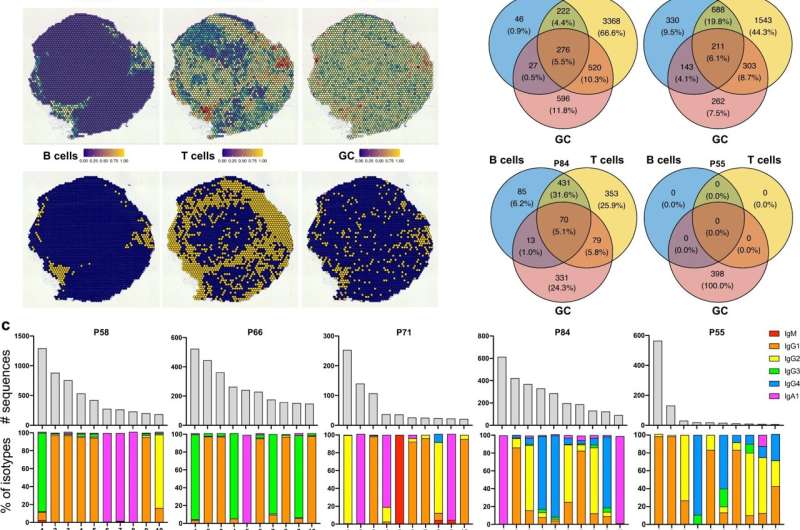This article has been reviewed according to Science X's editorial process and policies. Editors have highlighted the following attributes while ensuring the content's credibility:
fact-checked
peer-reviewed publication
trusted source
proofread
Study uncovers how B cells react to skin cancer

A new study that sheds light on how B cells react to skin cancer cells could pave the way for innovative therapy design.
The study, published today in Nature Communications and led by researchers from King's College London, reveals that antibody-producing B cells in patients may be defective in responding to the most aggressive skin cancer, melanoma.
Antibodies are produced by B cells, a type of white blood cell, and are made to prevent and help fight infections. However, there is limited understanding about how B cells are prompted to respond to melanoma and why the antibodies they make are not effective.
Researchers used advanced technologies to delve into the intricate workings of the antibody immune response in blood and tissues of patients with metastatic cutaneous melanoma. The blood of patients with late-stage secondary melanoma shows significantly lower levels of mature (memory) B cells, which normally provide long-term protection from infections. This means that the antibody-producing B cells in the blood may be less able to mount effective responses against cancer.
The research also finds that active B cells accumulate at the edge of the tumor and gather in small groups. These B cells carry specific antibody features and react to melanoma by assembling and communicating with each other, and with another immune cell type known as T cells.
In those melanoma lesions where B cells express specific antibody isotypes, such as IgG which better activates the immune system, the presence of B cells is associated with more favorable patient survival.
The research also finds that B cells in patients with metastatic melanoma also make antibodies which have similar functions to pathogenic antibodies seen in autoimmune diseases, such as the recognition of normal non-cancerous cells. These characteristics may prevent the immune system from mounting a strong response to clear melanoma.
First author Dr. Silvia Crescioli, from King's College London, said, "Our research provides a new perspective on the aberrant nature of B cell phenotypes, antibody characteristics and what they recognize in metastatic cutaneous melanoma. By uncovering autoimmune signatures and the highly active, yet abnormal, B cell response in the tumor microenvironment, we open doors to specific treatment advancements."
Dr. Joseph Ng, from University College London, co-author of the study said, "Through analyzing large datasets of B cell and antibody profiles found in melanoma, we can gather in-depth knowledge of the types of responses that may offer anti-tumor benefit, and this could provide clues for the development of novel treatments."
Lead author Professor Sophia Karagiannis from King's College London, said, "The findings of this study offer a deeper understanding of the intricate immune response deficits involved in metastatic cutaneous melanoma and their potential clinical significance. We are studying B cell signatures in different and larger cohorts of patients to better understand how these deficient antibody responses we have uncovered may be linked to patient outcomes."
"We are conducting extended research to elucidate how B cells interact with cancer cells and to dissect the conditions that initiate and enhance effective B cell and antibody responses. Together, these will offer opportunities for innovative therapy design in future."
More information: Silvia Crescioli et al, B cell profiles, antibody repertoire and reactivity reveal dysregulated responses with autoimmune features in melanoma, Nature Communications (2023). DOI: 10.1038/s41467-023-39042-y




















